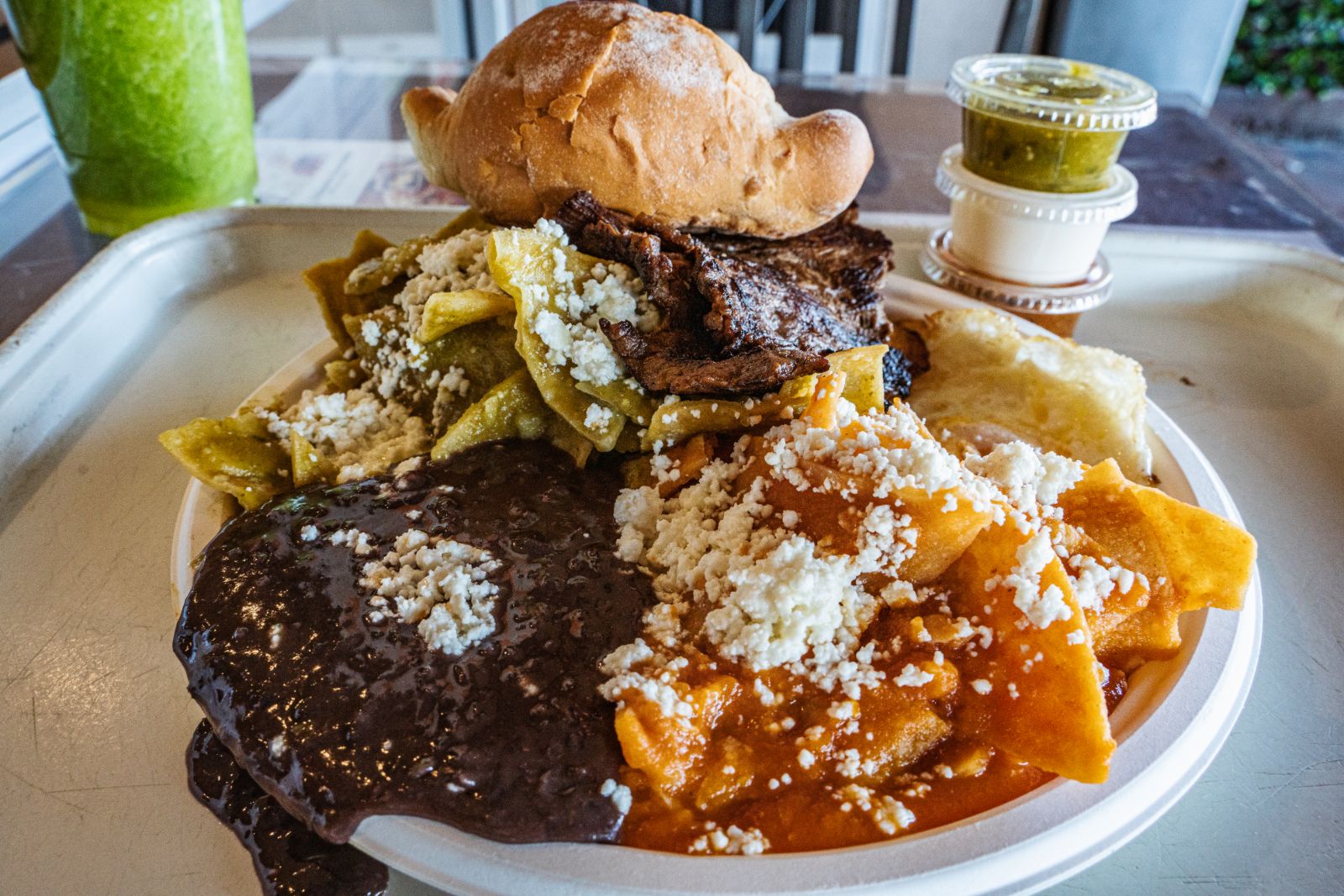[dropcap size=big]T[/dropcap]he first crunchy bite of the salsa smothered totopo—the proper word to call a tortilla chip—hits like the first notes of El Son de La Negra, slowly waking your taste buds to the brisk and sensational flavor of its sazón. It’s an addictive flavor that’s aided and abetted by the still-very-crunchy texture of each totopo. As if the near-perfect flavor and texture of the totopos wasn’t enough, the bite only gets better as you dive into the pool of silky black beans next to the totopos.
The fried tortilla chips are simmered with either a green tomatillo-based sauce or a vibrant red one without losing the chip’s crispy edge. If you asked for divorced chilaquiles, you would enjoy both side-by-side on the same plate with black beans, a plush freshly-baked bolillo, and fried plantains.
Once you’re done, sponge up the remaining sauce on the plate with their crusty, fluffy fresh-baked bolillo and finish it off with that sweet fried plantain to soothe your buds. For home-like comfort food, these chilaquiles are as exciting as it gets.
But how do plantains end up on a plate of spicy chilaquiles from Guadalajara? The black beans with queso fresco are a little less suspicious, considering black beans, although not familiar to Jalisco, tend to be more common in Mexico’s southern parts. But it begs the question, how did the westside’s most loved chilaquiles with plátanos fritos happen at a small bakery on Venice Boulevard named Venice Bakery & Restaurant?
Not much is known about when Venice Bakery was first opened. Other than it belonged to a Cubano named Jesus Reyes, who also owned El Camaguey, a carnicería on the same block. In 2002, before announcing he was selling the bakery, Reyes approached his most trusted and dedicated employee, Norma Mejía, and offered it to her. “He always had a lot of appreciation for her,” says Edith Aceves about her mother. “She always looked out for his business, so he wanted to show his appreciation and asked her if she wanted it.”
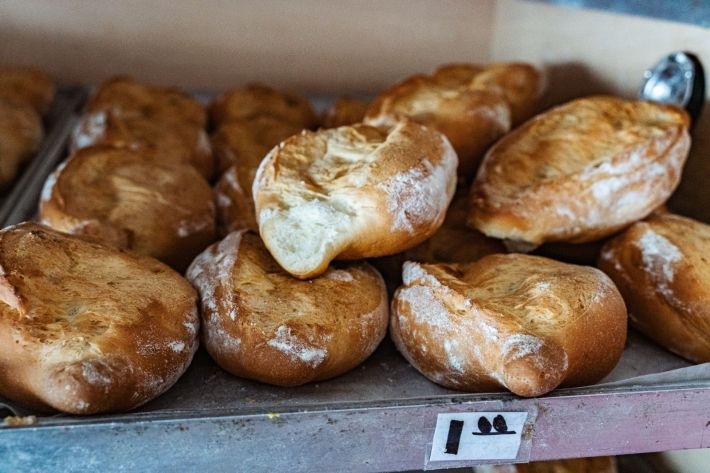
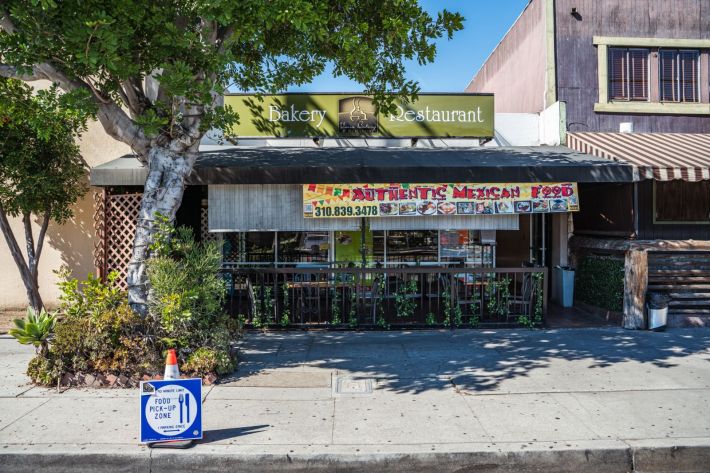
Aceves, who is 36-years-old, grew up across the street. Back then, it was only known as the Venice Bakery, “My mom added the ‘and restaurant’ part,” Aceves tells L.A. TACO. The bakery only sold some basic Mexican pan dulce, pastelitos, and Cuban cafecitos before the chilaquiles arrived.
Up until recently, the neighborhood was densely populated by Cubans. Aceves tells us, “People still call us the Cuban bakery because of all the viejitos that hung out in the patio every morning drinking espresso.” She laments that most of that generation of older Cubanos has recently passed, and most of their children have all moved away.
The actual chilaquiles are Mejía’s sister’s recipe, AltaGracia Muñoz. Mejía flew her in from Guadalajara to help her with her restaurant menu, including revamping the pan dulce selection.
Even with the restaurant’s semi-Cuban roots, the chilaquiles with the plantains aren’t leftover from the bakery’s Cuban past, but rather Mejías exposure to Cubanos. A year into owning the Venice Bakery, Mejía remarried a Cuban man from Glendale, and that’s where she began enjoying some of the Cuban dishes a bit more. When she first started selling chilaquiles, she offered them with frijoles pintos but decided to switch it up with black beans and plantains after enjoying them at home. The rest is chilaquiles history on Venice Boulevard.
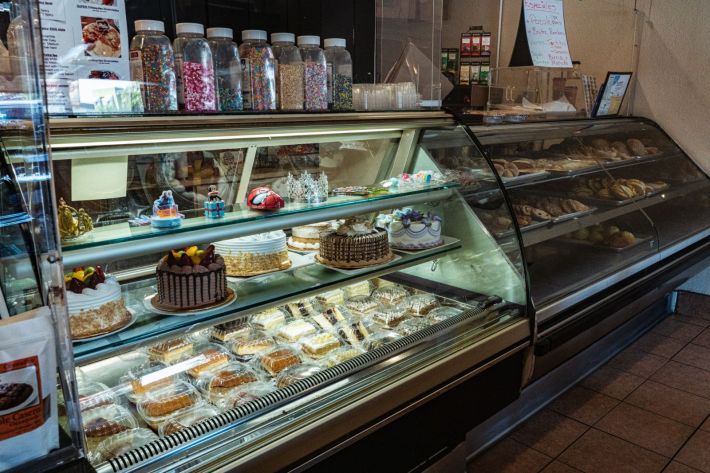
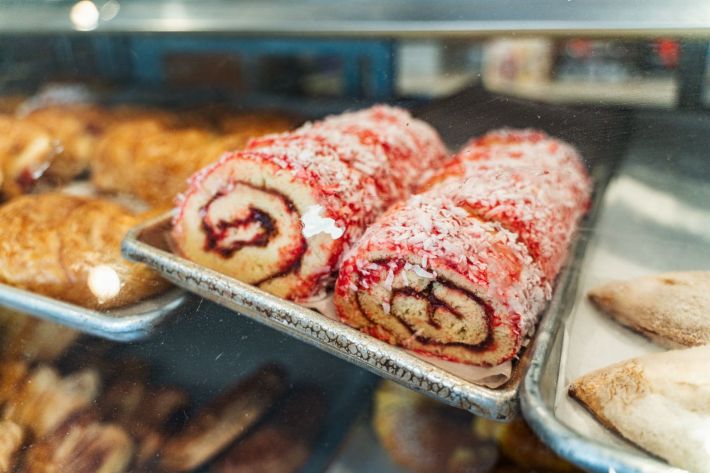
The actual chilaquiles are Mejía’s sister’s recipe, AltaGracia Muñoz. Mejía flew her in from Guadalajara to help her with her restaurant menu, including revamping the pan dulce selection. They brought in more traditional bread recipes but kept the quesadilla Salvadoreña and cuernos chapines, a Guatemalan bread. They still have Cuban pastelitos, puff pastries filled with beef, guayaba, or guayaba with cheese. And they still do a cortadito, a Cuban espresso with just a splash of milk and foam on top. “Mom used to give a cortadito to anyone who showed up to work sleepy,” Aceves recalls. “She would say, oh yoúre sleepy? Espérate! Órale chingate un cortadito.”
When you order your chilaquiles, drizzle some Mexican crema on top, and enjoy the warm history of these chilaquiles as they engulf your mouth with flavor.
Mejía was a staunch woman full of love and grit. She captained the restaurant from the register, directed the loyal staff of bustling women with her commanding voice, greeted new customers with her endearing smile, and joshed with the neighborly customer she’s known her whole American life. The community around Venice Bakery knew Mejiía this way, who, as family legend has it, “Crossed the border pregnant and in high-heels,” Aceves tells us.
“Mom passed away in October 2017 of cancer. One day she was happy running around and the next . . .” Aceves tells L.A. TACO, unable to finish her sentence. Aceves, who’s worked at the restaurant since she was 17, now stands behind the register where her mom did. Mejía may not be physically present, but her smile still shines through her daughter’s face, and she still overlooks the restaurant from a portrait on the right-hand wall.
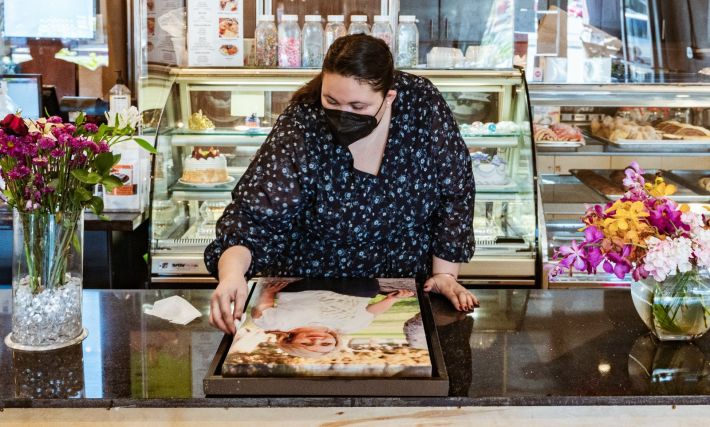
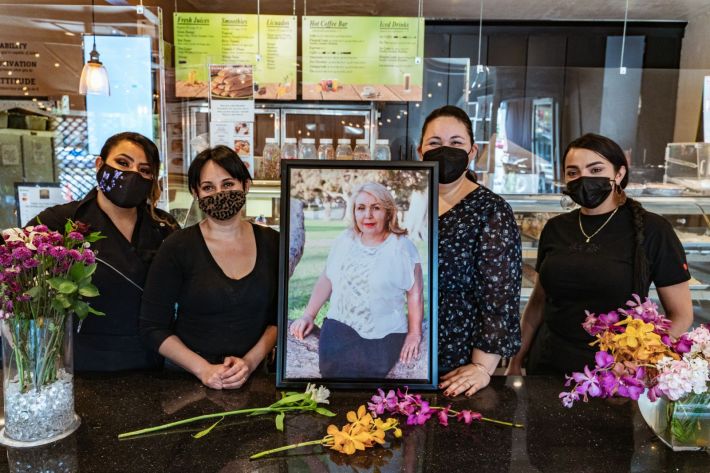
Aceves has her brother, Orlando, who backs her up and loyal staff of women who worked almost their entirety with Mejía. “The newest employee we have has been here for three years already,” Aceves tells L.A. TACO, emphasizing the unity and longevity of the staff. She pulls out a picture in her phone of about 20 people and tells us, “These are all people that worked with my mom. She asked everyone to dress in white for her funeral. They all came.”
Venice Bakery remains unchanged under Aceves and has even endured through the pandemic thanks to the loyal neighborhood. “The kids of the older Cubanos will still make the drive here to pick up pastelitos like when their parents used to send them walking when they were kids,” according to Aceves, speaking to the lasting legacy a small bakery can have on a community and generations after it.
When you order your chilaquiles, drizzle some Mexican crema on top, and enjoy the warm history of these chilaquiles as they engulf your mouth with flavor. Appreciate the loud crunch of chips as bold as Mama Mejías boisterous love. And when you drink your cafecito, be it a cafe de olla or an espresso, remember the old Cubanos who spent their mornings there enjoying the sounds of cars rumbling by on the boulevard.
Venice Bakery & Restaurant is at 10943 Venice Blvd, Los Angeles, CA 90034
